Enhancing Environmental Sustainability: Risk Assessment and Management Strategies for Urban Light Pollution
Abstract
1. Introduction
2. Literature Review
2.1. Strategy Development on Light Pollution Prevention
2.2. Research on Risk Assessment Methods of Light Pollution
2.3. Application of Combined Weighting Method and Synthetic Control Method
3. Materials and Methods
3.1. Model Construction
3.1.1. Light Pollution Risk Level Assessment Model
3.1.2. Light Pollution Risk Intervention Strategy Model
3.2. Data Description
3.2.1. Data Sources
3.2.2. Data Processing
3.3. The LPRLA Model Based on Comprehensive Evaluation Method
3.3.1. Basic Weighting Method
- (1)
- AHP is a multi-standard decision analysis method, which analyzes complex decision problems through hierarchical structure model and paired comparison so as to obtain the weight of each option. The root method is used to calculate the approximate value of the matrix eigenvector. AHP can combine the factors at different levels to form a multi-level analysis structure model based on the correlation and membership of the factors affecting the light pollution index, so this method is adopted. The calculation process is as follows:
- (2)
- IWM determines weights by analyzing the independence of indicators, calculates the correlation among indicators, reduces the influence of indicators with high correlation on weight distribution, and avoids the weight distortion caused by the interdependence of indicators. The method is an objective weighting method, which can extract data features more accurately.
- (3)
- EWM uses information entropy to determine the weight of each indicator and obtain an objective weight allocation.
- (4)
- CV is a statistical method that assigns weights by calculating the coefficient of variation of indicators. The greater the coefficient of variation, the higher the weight. The actual value of each variable is processed with data standardization, and then the weighted average method is adopted to determine the comprehensive score. The formula for calculating the coefficient of variation of each indicator is as follows:
- (5)
- CRITIC determines the weight of each indicator and reflects the relative importance of each indicator by analyzing the correlation and comparison strength of each indicator. For the CRITIC method, when the degree of positive correlation between the two indicators is greater, the conflict is smaller, which indicates that the information reflected by the two indicators in the evaluation of the pros and cons of the scheme is relatively similar.
- (6)
- PCA converts high-dimensional data to low-dimensional data while retaining the maximum amount of information and determines the weight of each index by calculating the contribution rate of principal components.
3.3.2. Combined Weights
3.3.3. Weight Calculation
3.4. Model of Light Pollution Risk Intervention Strategies Based on the Synthetic Control Method
3.4.1. Gaussian Mixed Model
3.4.2. Synthetic Control Methods
- Ignore the effects of the three strategies and other related policies.
- Disregard the impact of time differences in the implementation of policies in each city.
- Disregard the intensity changes of the three strategies themselves over time. Only one strategy implementation time point is considered.
4. Results
4.1. LPRLA Model Results and LPRL Distribution
- Each weighting indicator has a similar explanatory effect on the light pollution risk level, ranging from 0.1 to 0.2. This consistency indicates that the selected indicators are reasonably persuasive, and the model is rational.
- The regional development level has the most significant explanatory effect on the light pollution risk level. In this study, we measured regional development using two indicators, POP and GRP, with corresponding weights of 0.1746 and 0.1699, respectively. These indicators rank first and third, respectively, in terms of weight proportion, indicating a substantial influence on the regional development level index. In regions with large populations, high population density results in more significant negative impacts on a greater number of people, even with the same level of light pollution. Moreover, economically developed regions with high housing density have a high demand for electricity. Population concentration often correlates with higher economic levels, GDP, and per capita disposable income. In such areas, there are multiple consumption options and a relatively rich nightlife, leading to the use of all-day lighting for road illumination to ensure safety and convenience. Consequently, light pollution in these areas is more severe, corresponding to a higher risk level.
- Geographically, coastal and mountainous regions tend to have higher LPRL. Coastal areas are economically developed, with flat terrain and dense populations, resulting in significant harm from light pollution. Mountainous areas often have fragile ecosystems and serve as wildlife reserves, where light pollution may have more adverse effects on animals. Therefore, light pollution poses more severe threats to mountainous areas, which face higher levels of light pollution risk.
4.2. Analysis of Regional Differences in LPRL
4.3. Three Intervention Strategies
4.4. Analysis of the Three Strategies
4.5. Model Robustness Test
5. Discussion
6. Conclusions
Author Contributions
Funding
Institutional Review Board Statement
Informed Consent Statement
Data Availability Statement
Acknowledgments
Conflicts of Interest
References
- Guarnieri, M. An Historical Survey on Light Technologies. IEEE Access 2018, 6, 25881–25897. [Google Scholar] [CrossRef]
- Fouquet, R.; Pearson, P.J.G. Seven Centuries of Energy Services: The Price and Use of Light in the United Kingdom (1300–2000). Energy J. 2006, 27, 139–177. [Google Scholar] [CrossRef]
- Kyba, C.C.M.; Kuester, T.; Sánchez de Miguel, A.; Baugh, K.; Jechow, A.; Hölker, F.; Bennie, J.; Elvidge, C.D.; Gaston, K.J.; Guanter, L. Artificially lit surface of Earth at night increasing in radiance and extent. Sci. Adv. 2017, 3, e1701528. [Google Scholar] [CrossRef] [PubMed]
- Lu, Y. The current status and developing trends of Industry 4.0: A Review. Inf. Syst. Front. 2021, 1–20. [Google Scholar] [CrossRef]
- Schulte-Römer, N. Innovating in Public. The Introduction of LED Lighting in Berlin and Lyon. Ph.D. Thesis, Technical University Berlin, Berlin, Germany, 2015; pp. 321–324. [Google Scholar] [CrossRef]
- Schulte-Römer, N. Sensory governance: Managing the public sense of light and water. In Sensing Collectives—Aesthetic and Political Practices Intertwined; Voß, J.-P., Rigamonti, N., Suarez, M., Watson, J., Eds.; Transkript: Bielefeld, Germany, 2024; forthcoming. [Google Scholar]
- Riegel, K.W. Light pollution: Outdoor lighting is a growing threat to astronomy. Science 1973, 179, 1285–1291. [Google Scholar] [CrossRef] [PubMed]
- Hamacher, D.W.; De Napoli, K.; Mott, B. Whitening the sky: Light pollution as a form of cultural genocide. arXiv 2020, arXiv:2001.11527. [Google Scholar]
- Svechkina, A.; Portnov, B.A.; Trop, T. The impact of artificial light at night on human and ecosystem health: A systematic literature review. Landsc. Ecol. 2020, 35, 1725–1742. [Google Scholar] [CrossRef]
- Hatori, M.; Gronfier, C.; Van Gelder, R.N.; Bernstein, P.S.; Carreras, J.; Panda, S.; Marks, F.; Sliney, D.; Hunt, C.E.; Hirota, T.; et al. Global rise of potential health hazards caused by blue light-induced circadian disruption in modern aging societies. NPJ Aging Mech. Dis. 2017, 3, 9. [Google Scholar] [CrossRef] [PubMed]
- Falchi, F.; Cinzano, P.; Elvidge, C.D.; Keith, D.M.; Haim, A. Limiting the impact of light pollution on human health, environment and stellar visibility. J. Environ. Manag. 2011, 92, 2714–2722. [Google Scholar] [CrossRef]
- Kuijper, D.P.J.; Schut, J.; van Dullemen, D.; Toorman, H.; Goossens, N.; Ouwehand, J.; Limpens, H. Experimental evidence of light disturbance along the commuting routes of pond bats (Myotis dasycneme). Lutra 2008, 51, 37. [Google Scholar]
- Brüning, A.; Hölker, F.; Franke, S.; Preuer, T.; Kloas, W. Spotlight on fish: Light pollution affects circadian rhythms of European perch but does not cause stress. Sci. Total Environ. 2015, 511, 516–522. [Google Scholar] [CrossRef] [PubMed]
- van Geffen, K.G.; van Eck, E.; de Boer, R.A.; van Grunsven, R.H.; Salis, L.; Berendse, F.; Veenendaal, E.M. Artificial light at night inhibits mating in a Geometrid moth. Insect Conserv. Divers. 2015, 8, 282–287. [Google Scholar] [CrossRef]
- Bennie, J.; Davies, T.W.; Cruse, D.; Gaston, K.J. Ecological effects of artificial light at night on wild plants. J. Ecol. 2016, 104, 611–620. [Google Scholar] [CrossRef]
- Irwin, A. The dark side of light: How artificial lighting is harming the natural world. Nature 2018, 553, 268–270. [Google Scholar] [CrossRef] [PubMed]
- Meier, J.; Hasenöhrl, U.; Krause, K.; Pottharst, M. (Eds.) Urban Lighting, Light Pollution and Society; Routledge: New York, NY, USA, 2015. [Google Scholar]
- MacGregor, C.J.; Pocock, M.J.O.; Fox, R.; Evans, D.M. Pollination by nocturnal L epidoptera, and the effects of light pollution: A review. Ecol. Entomol. 2015, 40, 187–198. [Google Scholar] [CrossRef] [PubMed]
- Longcore, T.; Rich, C. Ecological light pollution. Front. Ecol. Environ. 2004, 2, 191–198. [Google Scholar] [CrossRef]
- Hölker, F.; Moss, T.; Griefahn, B.; Kloas, W.; Voigt, C.C.; Henckel, D.; Hänel, A.; Kappeler, P.M.; Völker, S.; Schwope, A.; et al. The dark side of light: A transdisciplinary research agenda for light pollution policy. Ecol. Soc. 2010, 15, 13. [Google Scholar] [CrossRef]
- Gaston, K.J.; Bennie, J.; Davies, T.W.; Hopkins, J. The ecological impacts of nighttime light pollution: A mechanistic appraisal. Biol. Rev. 2013, 88, 912–927. [Google Scholar] [CrossRef] [PubMed]
- Agarwal, A.; Xue, L. Model-based clustering of nonparametric weighted networks with application to water pollution analysis. Technometrics 2020, 62, 161–172. [Google Scholar] [CrossRef]
- Davies, T.W.; Bennie, J.; Inger, R.; De Ibarra, N.H.; Gaston, K.J. Artificial light pollution: Are shifting spectral signatures changing the balance of species interactions? Glob. Chang. Biol. 2013, 19, 1417–1423. [Google Scholar] [CrossRef]
- Kolláth, Z. Measuring and modelling light pollution at the Zselic Starry Sky Park. J. Phys. Conf. Ser. 2010, 218, 012001. [Google Scholar] [CrossRef]
- Cinzano, P.; Falchi, F. The propagation of light pollution in the atmosphere. Mon. Not. R. Astron. Soc. 2012, 427, 3337–3357. [Google Scholar] [CrossRef]
- Pun, C.S.J.; So, C.W. Night-sky brightness monitoring in Hong Kong: A city-wide light pollution assessment. Environ. Monit. Assess. 2012, 184, 2537–2557. [Google Scholar] [CrossRef]
- Liu, M.; Ma, J.; Su, X.; Zhang, B. The effects of dynamic interference light on human vision, psychology, and emotion. Ergonomics 2009, 15, 21–24. [Google Scholar] [CrossRef]
- Jieqiao, S.; Lixiong, W.; Mingyu, Z.; Aiying, W.; Juan, Y. Study on Light Environment Partition Control Index Based on Light Trespass Control of Urban Nightscape. China Illum. Eng. J. 2015, 26, 1–6+13. [Google Scholar]
- Su, X.; Hao, Z. The Research on Lighting Trespass from Roadway Lighting. China Illum. Eng. J. 2012, 23, 46–50+65. [Google Scholar] [CrossRef]
- Feng, K.; Hao, L.; Zeng, K. Discussion on Evolution Characteristics of Urban Lighting Pollution: Taking Research on VIIRS Images. China Illum. Eng. J. 2022, 33, 1–10. [Google Scholar]
- Lu, W.; Zhang, X.; Zhan, X. Movie box office prediction based on IFOA-GRNN. Discret. Dyn. Nat. Soc. 2022, 2022, 3690077. [Google Scholar] [CrossRef]
- Li, M.; Wang, T.; Lu, W.; Wang, M. Optimizing the systematic characteristics of online learning systems to enhance the continuance intention of Chinese college students. Sustainability 2022, 14, 11774. [Google Scholar] [CrossRef]
- Lu, W.; Xing, R. Research on movie box office prediction model with conjoint analysis. Int. J. Inf. Syst. Supply Chain Manag. (IJISSCM) 2019, 12, 72–84. [Google Scholar] [CrossRef]
- Lu, W.; Deng, P.; Shen, Z. Research on user stickiness of mobile games. In Proceedings of the 2021 International Conference on Culture-Oriented Science & Technology (ICCST), Beijing, China, 18–21 November 2021; IEEE: Piscataway, NJ, USA, 2021; pp. 160–166. [Google Scholar]
- Dhanalakshmi, M.; Radha, V. Discretized Linear Regression and Multiclass Support Vector Based Air Pollution Forecasting Technique. Int. J. Eng. Trends Technol. 2022, 70, 315–323. [Google Scholar]
- Lu, Y.; Ning, X. A vision of 6G–5G’s successor. J. Manag. Anal. 2020, 7, 301–320. [Google Scholar] [CrossRef]
- Liu, Z.; Mostafavi, A. Collision of environmental injustice and sea level rise: Assessment of risk inequality in flood-induced pollutant dispersion from toxic sites in Texas. arXiv 2023, arXiv:2301.00312. [Google Scholar]
- Messier, K.P.; Katzfuss, M. Scalable penalized spatiotemporal land-use regression for ground-level nitrogen dioxide. Ann. Appl. Stat. 2021, 15, 688–710. [Google Scholar] [CrossRef] [PubMed]
- Zhou, Y.; Wei, F. Application of Combinatorial Empowerment Method in Enterprise Performance Evaluation. Ind. Eng. Manag. 2007, 12, 51–54. [Google Scholar]
- Cao, M.; Xu, T.; Yin, D. Understanding light pollution: Recent advances on its health threats and regulations. J. Environ. Sci. 2023, 127, 589–602. [Google Scholar] [CrossRef] [PubMed]
- Lima, R.C.; Pinto da Cunha, J.; Peixinho, N. Light pollution: Assessment of sky glow on two dark sky regions of Portugal. J. Toxicol. Environ. Health Part A 2016, 79, 307–319. [Google Scholar] [CrossRef]
- Kernbach, M.E.; Hall, R.J.; Burkett-Cadena, N.D.; Unnasch, T.R.; Martin, L.B. Dim light at night: Physiological effects and ecological consequences for infectious disease. Integr. Comp. Biol. 2018, 58, 995–1007. [Google Scholar] [CrossRef] [PubMed]
- Vaz, S.; Manes, S.; Gama-Maia, D.; Silveira, L.; Mattos, G.; Paiva, P.C.; Figueiredo, M.; Lorini, M.L. Light pollution is the fastest growing potential threat to firefly conservation in the Atlantic Forest hotspot. Insect Conserv. Divers. 2021, 14, 211–224. [Google Scholar] [CrossRef]
- Xiang, W.; Tan, M. Changes in Light Pollution and the Causing Factors in China’s Protected Areas, 1992–2012. Remote Sens. 2017, 9, 1026. [Google Scholar] [CrossRef]
- Ngarambe, J.; Kim, G. Sustainable Lighting Policies: The Contribution of Advertisement and Decorative Lighting to Local Light Pollution in Seoul, South Korea. Sustainability 2018, 10, 1007. [Google Scholar] [CrossRef]
- Gili, F.; Fassone, C.; Rolando, A.; Bertolino, S. In the Spotlight: Bat Activity Shifts in Response to Intense Lighting of a Large Railway Construction Site. Sustainability 2024, 16, 2337. [Google Scholar] [CrossRef]
- Li, J.; Xu, Y.; Cui, W.; Ji, M.; Su, B.; Wu, Y.; Wang, J. Investigation of Nighttime Light Pollution in Nanjing, China by Mapping Illuminance from Field Observations and Luojia 1-01 Imagery. Sustainability 2020, 12, 681. [Google Scholar] [CrossRef]
- Zielińska-Dabkowska, K.M.; Xavia, K.; Bobkowska, K. Assessment of Citizens’ Actions against Light Pollution with Guidelines for Future Initiatives. Sustainability 2020, 12, 4997. [Google Scholar] [CrossRef]
- Lu, Y. Implementing blockchain in information systems: A review. Enterp. Inf. Syst. 2022, 16, 2008513. [Google Scholar] [CrossRef]
- Papalambrou, A.; Doulos, L.T. Identifying, Examining, and Planning Areas Protected from Light Pollution. The Case Study of Planning the First National Dark Sky Park in Greece. Sustainability 2019, 11, 5963. [Google Scholar] [CrossRef]
- Lu, Y.; Sigov, A.; Ratkin, L.; Ivanov, L.A.; Zuo, M. Quantum Computing and Industrial Information Integration: A Review. J. Ind. Inf. Integr. 2023, 35, 100511. [Google Scholar] [CrossRef]
- Chen, H.; Xu, Z.; Liu, Y.; Huang, Y.; Yang, F. Urban Flood Risk Assessment Based on Dynamic Population Distribution and Fuzzy Comprehensive Evaluation. Int. J. Environ. Res. Public Health 2022, 19, 16406. [Google Scholar] [CrossRef] [PubMed]
- Chu, Y. Fire Risk Assessment of Ancient Buildings Based on Combination Weighting Method. Adv. Appl. Math. 2022, 11, 6079–6086. [Google Scholar] [CrossRef]
- Lu, Y.; Williams, T.L. Modeling analytics in COVID-19: Prediction, prevention, control, and evaluation. J. Manag. Anal. 2021, 8, 424–442. [Google Scholar] [CrossRef]
- Ye, Z.; Lu, Y. Quantum science: A review and current research trends. J. Manag. Anal. 2022, 9, 383–402. [Google Scholar] [CrossRef]
- Abadie, A.; Diamond, A.; Hainmueller, J. Synthetic Control Methods for Comparative Case Studies: Estimating the Effect of California’s Tobacco Control Program. J. Am. Stat. Assoc. 2010, 105, 493–505. [Google Scholar] [CrossRef]
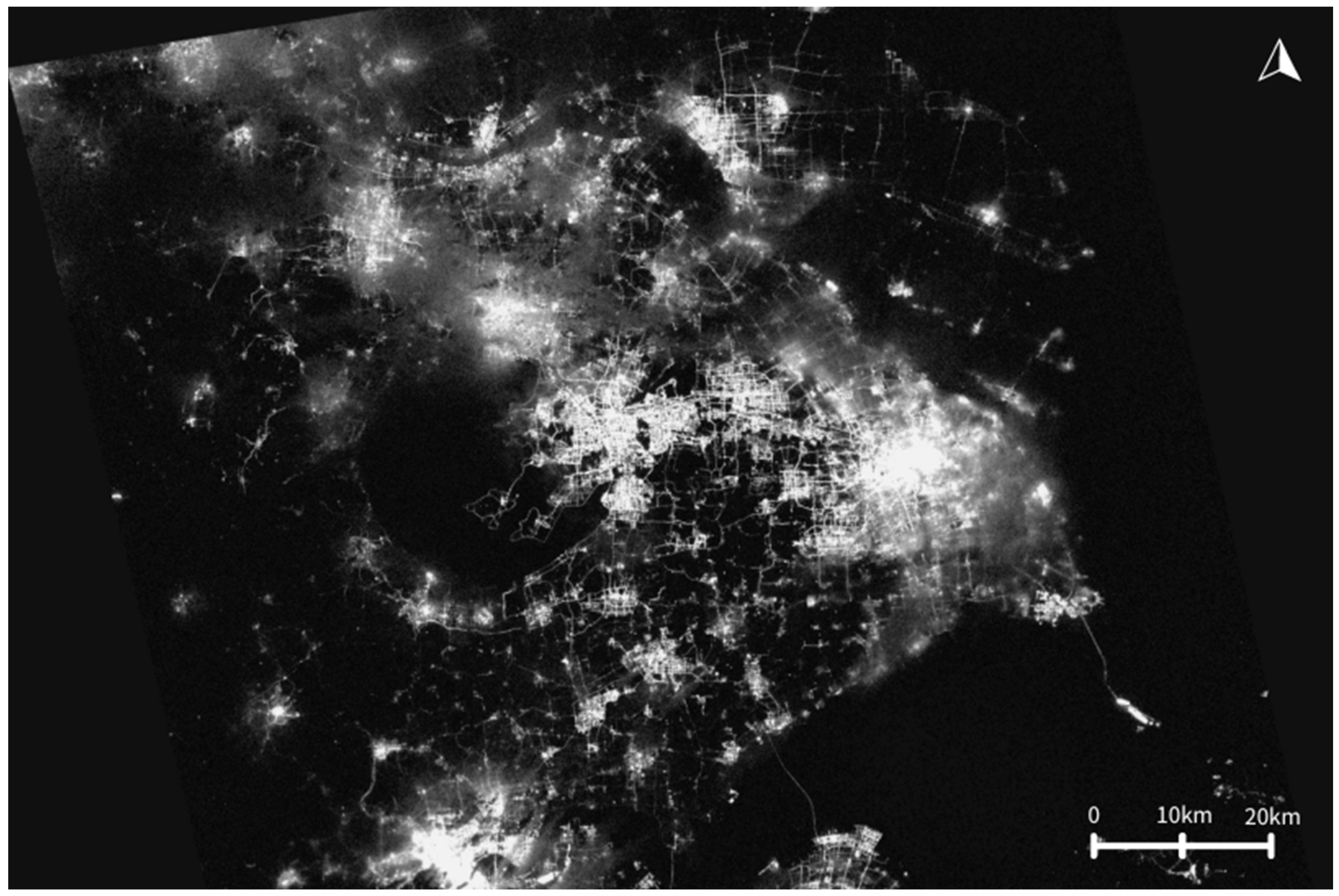

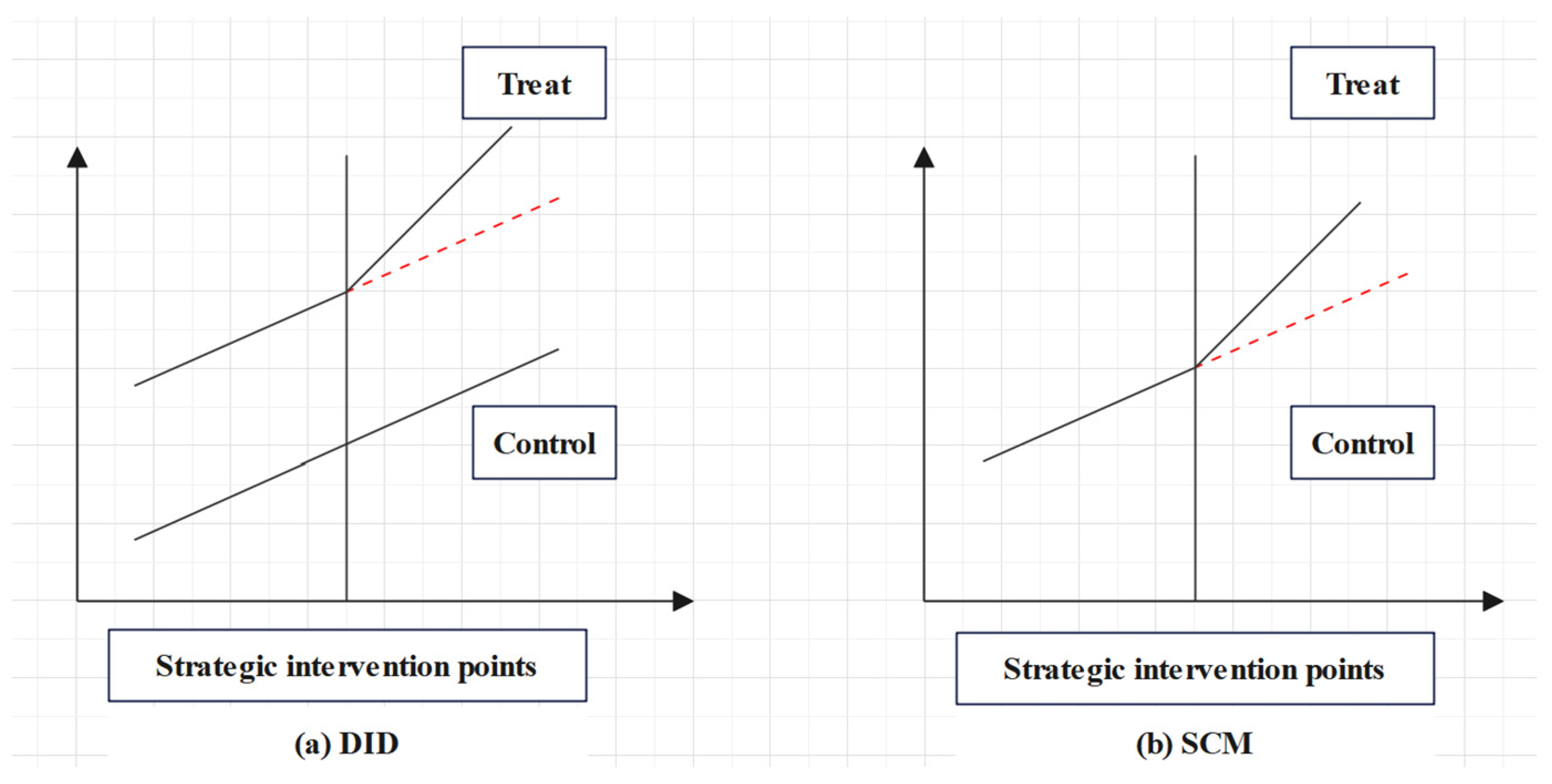
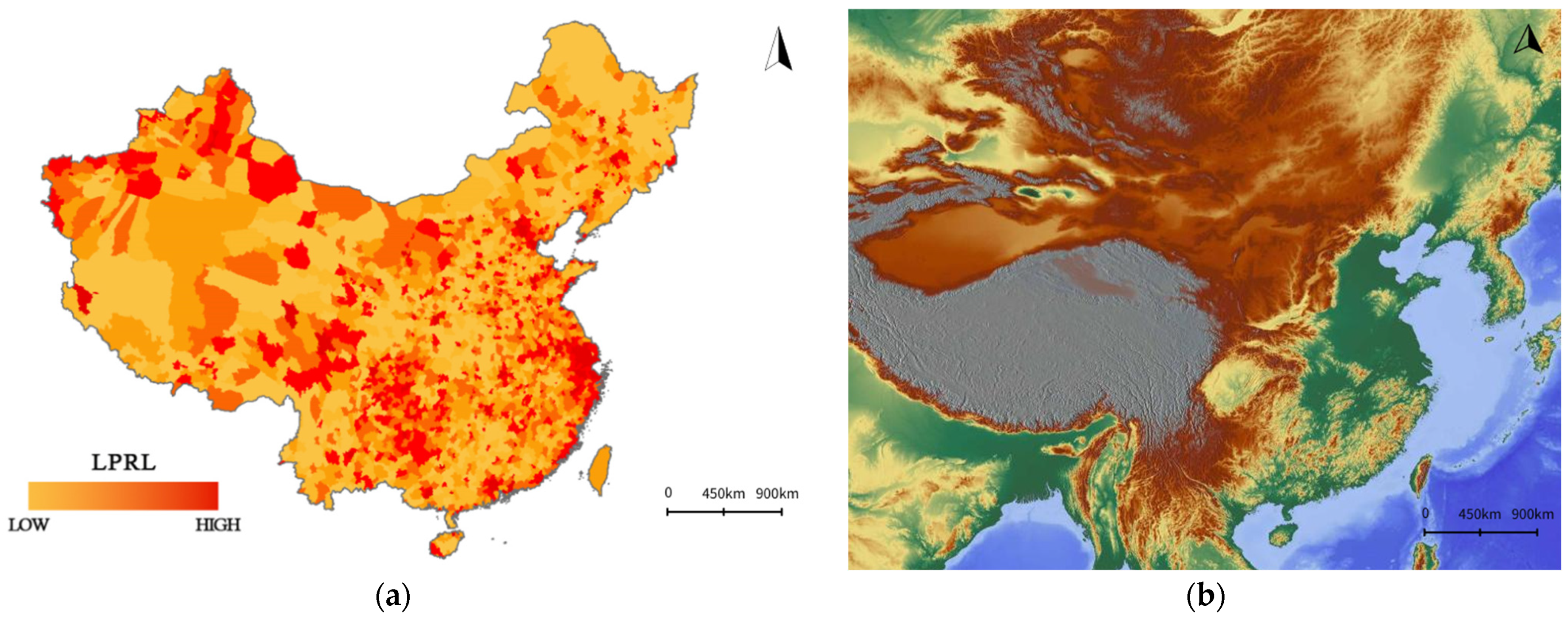
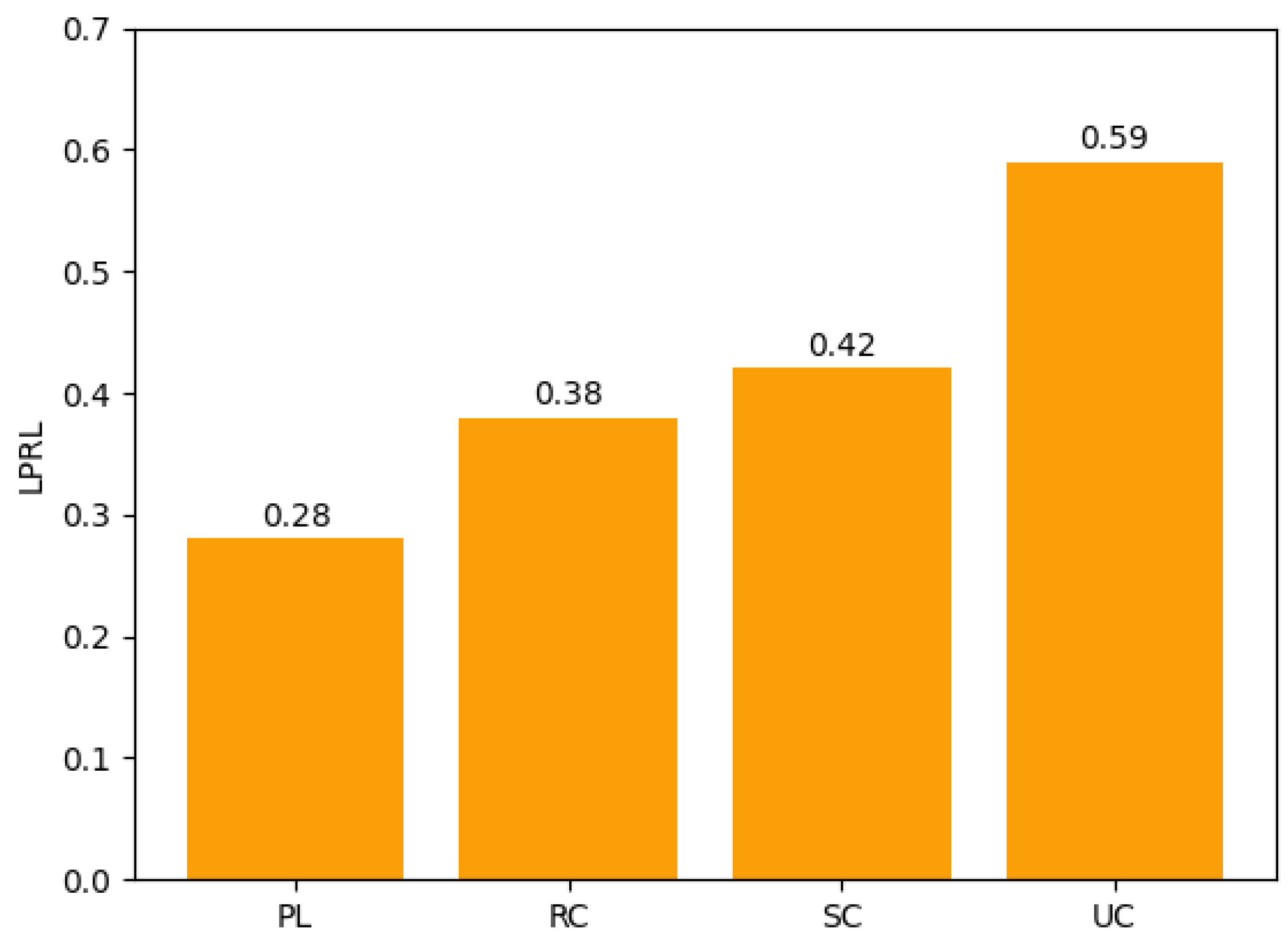
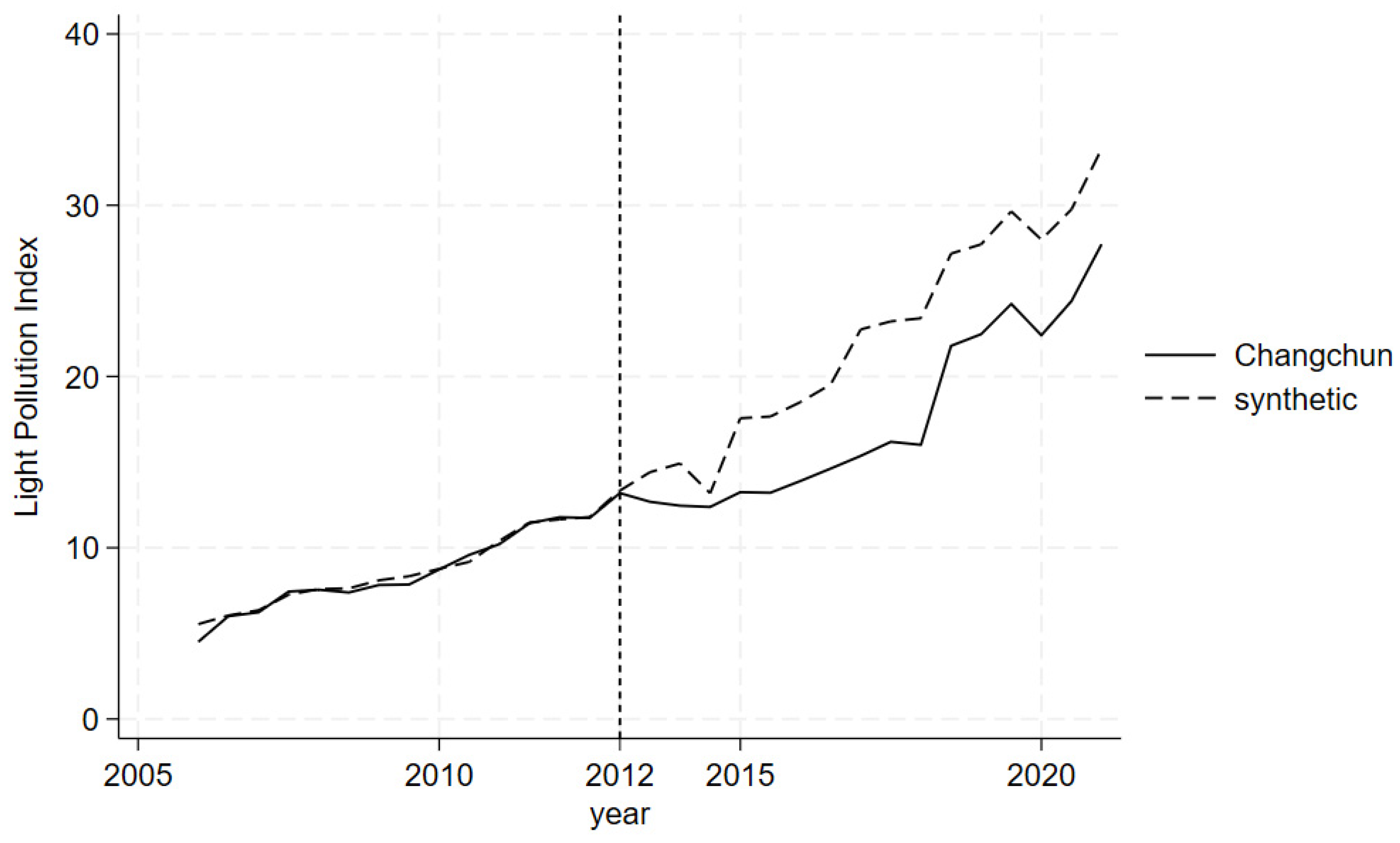





| Symbols | Impact Metrics |
|---|---|
| BDS | The Bortle Dark-Sky Scale |
| CNLI | Comprehensive Night-Time Light Index |
| S | Light Area Ratio |
| FRANLI | Relative Average Night-Time Light Index |
| LUD | Level of Urban Development |
| GRP | Gross Regional Product |
| POP | Population Size |
| AASD | Average Annual Sunshine Duration |
| WHA | Wildlife Habitat Area |
| Symbol | Definition |
|---|---|
| PL | Protected land |
| RC | Rural community |
| SC | Suburban community |
| UC | Urban community |
| Empowerment Methods | BDS | CNLI | GRP | POP | AASD | WHA |
|---|---|---|---|---|---|---|
| AHP | 0.1748 | 0.1569 | 0.1569 | 0.2190 | 0.1985 | 0.1351 |
| IWM | 0.1853 | 0.1592 | 0.1592 | 0.1413 | 0.1911 | 0.1848 |
| EWM | 0.0806 | 0.1192 | 0.1192 | 0.2863 | 0.1185 | 0.1320 |
| CV | 0.1073 | 0.1395 | 0.1395 | 0.2459 | 0.1304 | 0.1497 |
| CRITIC | 0.1204 | 0.1190 | 0.1190 | 0.1244 | 0.2602 | 0.2641 |
| PCA | 0.1596 | 0.1423 | 0.1423 | 0.2148 | 0.1279 | 0.1612 |
| Cluster Categories | City |
|---|---|
| UC | Shanghai, Beijing, Chengdu, Guangzhou, Wuhan, Chongqing, etc. |
| SC | Tianjin, Hefei, Jinan, Qingdao, Taiyuan, Nanjing, Shijiazhuang, Zhengzhou, Dalian, Xi’an, etc. |
| RC | Changchun, Nanning, Guilin, Nanchang, Hangzhou, Haikou, Changsha, Fuzhou, Guiyang, Shenyang, etc. |
| PL | Kunming, Hohhot, Yinchuan, Urumqi, Lanzhou, Lhasa, Xining, Harbin, etc. |
| Impact Metrics | Regional Classification | |||
|---|---|---|---|---|
| PL | RC | SC | UC | |
| LPRL | Relatively Low | Moderate | Slightly Higher | Relatively High |
| BDS | Relatively remote area with very little daylight and far from big cities. | Near cities or towns, sky light is still present. Other artificial light sources (areas subject to airports, highways) are small. | Closer to a nearby city or town, the sky light level is medium to high. | With a concentration of high-rise buildings, billboards and other artificial light sources, the downtown business district has a very high level of sky light. |
| CNLI | Artificial management and regulations are strict, and nature conservation is implemented. | Streetlights, outdoor security lights and commercial lighting exist in small towns. | Extensive use of outdoor lighting for commercial and residential purposes. | Street lighting, building façades, and commercial lighting applications are very wide and long-lasting. |
| LUD | Protected areas, mountainous terrain, relatively low population density, little economic development, and low demand for human artificial light. | The population density is low, and the economy is relatively underdeveloped. | Located near or within a large metropolitan area, hence high population density and high demand and level of artificial light. | It is usually located in the center of a large city, densely populated, with a very developed economy and high levels of artificial lighting. |
| AASD | Longer natural light hours and shorter artificial light hours resulted in lower LPRL levels in both cases. | |||
| WHA | There is a high potential for light pollution of animals in the reserve, but the site is open. | Located near wildlife habitat and may have a negative impact on local wildlife. | May be located near or in wildlife habitat, risk exists. | Wildlife habitat is not generally present. |
| Intervention Strategies | Reduce Light Time (RLT) | Improve Light Sources (ILS) | Improved Lighting Hardware (LIH) | Implementation of Greening Projects (IGP) | Implement Community Education (ICE) |
|---|---|---|---|---|---|
| Correlation Coefficient | 0.800 ** | 0.742 ** | 0.890 ** | 0.147 | 0.093 |
Disclaimer/Publisher’s Note: The statements, opinions and data contained in all publications are solely those of the individual author(s) and contributor(s) and not of MDPI and/or the editor(s). MDPI and/or the editor(s) disclaim responsibility for any injury to people or property resulting from any ideas, methods, instructions or products referred to in the content. |
© 2024 by the authors. Licensee MDPI, Basel, Switzerland. This article is an open access article distributed under the terms and conditions of the Creative Commons Attribution (CC BY) license (https://creativecommons.org/licenses/by/4.0/).
Share and Cite
Li, X.; Lu, W.; Ye, W.; Ye, C. Enhancing Environmental Sustainability: Risk Assessment and Management Strategies for Urban Light Pollution. Sustainability 2024, 16, 5997. https://doi.org/10.3390/su16145997
Li X, Lu W, Ye W, Ye C. Enhancing Environmental Sustainability: Risk Assessment and Management Strategies for Urban Light Pollution. Sustainability. 2024; 16(14):5997. https://doi.org/10.3390/su16145997
Chicago/Turabian StyleLi, Xinru, Wei Lu, Wang Ye, and Chenyu Ye. 2024. "Enhancing Environmental Sustainability: Risk Assessment and Management Strategies for Urban Light Pollution" Sustainability 16, no. 14: 5997. https://doi.org/10.3390/su16145997
APA StyleLi, X., Lu, W., Ye, W., & Ye, C. (2024). Enhancing Environmental Sustainability: Risk Assessment and Management Strategies for Urban Light Pollution. Sustainability, 16(14), 5997. https://doi.org/10.3390/su16145997


_Lu.png)





